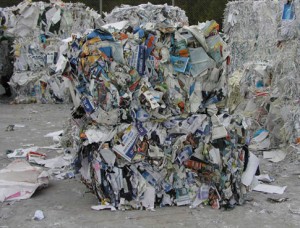Green Futures Article: Businesses use the same pristine paper, again and again

“What goes around, comes around.” I’m sure my granny said that, before Justin Timberlake. Not, in her case, to rebuke a lost lover, but a simple statement of how things were. Recycling was a way of life, and all the leftovers came round again, in one form or another. Usually the whole loop was clearly visible, as she fashioned new bobble-hats from the wool of old jumpers.
Now fast-forward 50 years, from that scene of homespun virtue to the technological sophistication and international scale of recycling in 2012. Paper and cardboard is a relative success story, with collection rates in Europe approaching two thirds of total usage. Which is just as well. Using recycled pulp in a paper mill not only saves trees, keeps methane out of landfill and cuts incinerator emissions; it can also cut energy and water use by as much as half compared with virgin fibre.
A lot of high-grade paper is recycled downstream into tissue or cardboard
But not all is rosy. A lot of the used ‘wood-free’ graphics-grade paper put out for collection in offices actually has a disappointing destiny, with much of it recycled ‘downstream’ into tissue, cardboard or newspaper. This wasn’t always the case.
The UK used to have three paper mills with the right technology to produce graphic paper from waste of the same grade. But at the time, there wasn’t enough demand to make the process profitable, and the mills were closed, leaving just six in Europe.
Now, a scheme called The Full Cycle, launched last September in the UK, aims to turn that around. Environment Manager Matthew Botfield at paper merchant Antalis McNaughton led on the scheme’s development. For him, it “seemed a logical next step to find a way to recover used graphic paper and recycle it back to its original standard”. Especially given that graphics-grade represents some 40% of all the paper used in Europe.
The solution has two key elements. One is a specialised de-inking technology, developed at the Greenfield plant 100km north-east of Paris, by Antalis’ sister company, paper makers Arjowiggins Graphic. The other is a closed loop service, which makes a positive virtue of selling back to clients top quality graphics grade paper made from the waste paper the subscribed businesses supply.
Companies can sign up to this scheme for free, enhancing their environmental kudos with an environmental declaration to say that their paper was recycled via The Full Cycle paper scheme.
The recovered waste paper is tracked via a materials traceability system quite similar to the well-known FSC Chain of Custody System. Waste paper is collected, shredded if necessary, then bundled off to Greenfield for de-inking and remanufacture. This mill specialises in making bright white recycled graphics-grade paper. To complete the full cycle, the mill delivers the paper back to the client.
“The cycle just works perfectly” for Arjowiggins Graphic too,
says Corporate Affairs Manager Shannan Hodgson.
“[Outside of the scheme] a lot of the recovered fibre (waste paper) is exported to China and Asia”, she explains. “However, with the Full Cycle Scheme the benefit will be to local markets.”
And the advantages don’t end with improved supply chain security. Up to half a million tonnes of waste paper are diverted from landfill or incineration, and the cycle also makes sense of transport arrangements:
“Arjowiggins Graphic delivery trucks make 1,500 trips a year [from northern France] to the UK, and a return journey loaded with used paper for recycling means they don’t run back empty to the mill each time – a big saving in terms of carbon dioxide emissions.”
Boosted by recognition at last autumn’s European Paper Recycling Awards, The Full Cycle paper scheme has high hopes. Can the reputational benefits it offers win over enough clients, both large and small, to make a major difference in this trickiest area of paper recycling?
While Full Cycle is growing in the UK, the launch of parallel arrangements in continental Europe will seek to enlarge the virtuous circle – ensuring more of the paper that comes around, goes around.
Roger East
Arjowiggins Graphic is a Forum for the Future Partner.